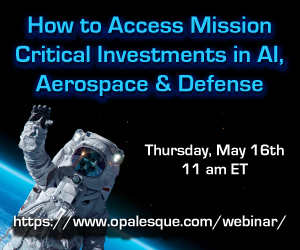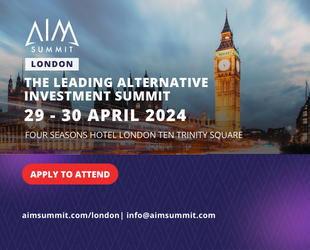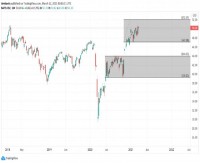|
Have UCITS had their time? Exploring costs, risks and asset raising.Salvatore Cordaro, Founding partner and CIO at Tages Capital, Marco d'Attanasio, founding partner and CIO at Hadron Capital, Karim Leguel CIO of Rasini Fairway Capital and Dhan Pai, COO and CFO at PSAM, joined me at the GAIM conference to share their experience in managing UCITS and non UCITS funds. Why did you launch a UCITS product? • Dhan Pai explained that for PSAM the decision to launch a european vehicle became pertinent because of specific european investors' request. Having run liquid versions of their flagship strategy through managed accounts for almost a decade, launching a UCITS was a logical development for PSAM. • Marco D'Attanasio explained that for Hadron Capital the decision to launch a UCITS-compliant fund was the result of some requests from existing investors in their flagship offshore fund who wanted exposure to different asset classes but with the protection of a UCITS framework. Having considered this request Hadron realised that the way their flagship fund was managed was already consistent with the UCITS guidelines and that it was possible to deliver the fundamental character of Hadron's investment DNA within the UCITS constraints. • Tages involvement into the UCITS industry is a natural extension of the work done by the team during its previous experience at a premiere global investment bank. There the team was responsible for the first and world largest UCITS fund of UCITS funds, launched in 2009. This was also driven by investor demand for transparency, liquidity and regulation and the team capitalized on this trend. Are costs an issue? • There are specific costs attached to launching a UCITS fund, including registration and passporting costs. However, the panel recognized that those costs are generally fixed costs, which will mostly impact smaller funds. As Dhan Pai says : « the vast majority of Alternative UCITS funds have sub-optimal AUM resulting in greater tracking error and higher TER. As funds increase in size and the tracking error, costs, etc. become less of an issue, it is easier to attract capital from institutional investors. • Marco d'Attanasio outlined that the managers' aim should be to bring the costs of their UCITS funds in line with their relevant offshore strategy and investor expectations. He also added that tracking error between a UCITS fund and its offshore version should be taken into account in the due diligence process as some strategies may experience replication issues. • The panel agreed that perceived additional costs of a regulated vehicle should not prevent managers form registering and running a UCITS. • Salvatore highlights how the Ucits regulation prevents managers to expense inappropriate costs to the fund (when compared to the flexibility of an offshore vehicle). There is also the "cost of regulation", which stems from more constraints on the investment universe. This translates over time in lower performance compared to the offshore sector, but (at least based on available research) this effect seems more than compensated by lower risk, leaving ucits alternative funds with better risk adjusted returns. • PSAM notes that reflecting the trend observed in the offshore space, UCITS investors have also become more sensitive about TER. In particular those traditionally investing in long only UCITS who see alternative UCITS as a diversifier who compare relative cost structure of a very broad range of products, including ETFs. • Salvatore agrees with Dhan, and quotes some research showing that the tracking error is diminishing as the industry matures and more assets are invested through UCITS vehicles Risks : are UCITS less risky products? • For the panel, risks are equal between investing in an offshore and a UCITS. The panel was concerned that investors could consider regulated vehicles as carrying less risks. Fraud risk, counterparty risks and even liquidity risks are in both regulated and non regulated funds. In the case of regulated vehicle, someone can be responsible, either a custodian, a regulator; however, investors must do their due diligence on operational issues for both structures. • One critical factor is understanding the strategy and the structure of the fund : how the assets are valued, in case of a complex strategy : what is the impact of a swap structure in terms of risks and costs. • From PSAM's experience in running their UCITS, liquidity mismatch is one of the risks/concerns that investors mention the most. PSAM's UCITS was launched almost 3 years ago and they believe that this track record generated over different periods and market environments now helps address those liquidity mismatch concerns. However, in the first few months after the launch, PSAM felt that their experience in running liquid versions of the main strategy through managed accounts was the best way to address those concerns. The fact that PSAM never gated, suspended liquidity or side pocketed investors even in their more liquid productswas a strong plus. • Dhan Pai adds that there has been concerns regarding how some strategies have been made UCITS compliant through the use of structuring techniques. He says it is critical for the industry's reputation to make sure managers comply with the spirit of the regulation as well. • Marco D'Attanasio agrees with Dhan about liquidity mismatch. Hadron decided to publish the NAV of their UCITS fund on a daily basis not because their investor base demands daily liquidity, but because they want to give the assurance that they would be able to liquidate the portfolio anytime at the price at which the securities are valued in the fund. • The level of liquidity in UCITS can become a risk factor for co-investors. The stability of the fund and its strategy can be at risk when suddenly the fun dis facing important redemptions. How can an investor appreciate that risk ? • Salvatore agrees that risks are similar to the offshore world (if not higher, as UCITS structures are often more complex). In particular, regulation risk of providing a false sense of security as investors tend to associate regulation with prevention of operational accidents. As for listed (regulated) equities, regulation itself does not prevent but surely mitigates the risk of frauds (think of Enron or Parmalat). Raising assets with UCITS • In both offshore and UCITS, the big players attract most of the investment flows. • Critical size, brand name and performances are critical factors to raise assets, especially institutional investors. • Salvatore outlined that as far as asset raising is concerned, most of the asset growth in alternatives post 2008 has been driven by US institutions, which by their nature are not the natural buyer of UCITS funds. Most of the growth of the industry in Europe has indeed been channelled via UCITS vehicles and we are seeing an acceleration of this via a virtuous cycle of "more assets get attracted, reducing tracking errors, and attracting to the industry more talented managers, which in turn attracts more investors to it". • PSAM also believes that it is critical for a manager to identify and communicate about the drivers of performance for their UCITS compared to their main strategy to appropriately manage investors' expectations. • Salvatore Cordaro mentioned that todays investors in Alternative UCITS are evolving towards even more institutional involvement. Investors in Long Only funds are now moving to Alternative UCITS. According to Salvatore, this larger range of investors is very positive. Dhan Pai confirms that they have been working with new types of investors, including traditionally long only products that invest cross assets, and that have been more actively monitoring the alternative UCITS space. • Dhan Pai considers that while there has been a growing number of funds covering various strategies launched over the past couple of years, some strategies are still under represented in the UCITS industry. There is additional benefits in terms asset raising for first entrants. • Karim Leguel thinks that investors are moving away from investing in big managers, perceived wrongly as safer. Smaller niche managers are offering capacity and attracting investors. • Marco D'Attanasio notes the increased institutionalisation of the UCITS phenomenon, which is able to capture different groups of investors attracted by the combination of liquidity, transparency and regulatory supervision but within a strategy provided by a hedge fund manager. Some of the traditional funds of hedge funds are looking at UCITS as a way to improve the liquidity profile of their offshore offering; some traditional long-biased multi-managers can finally access less directional strategies in a format which is suitable for their typical onshore structures. On the other hand, the private banks see the tax and regulatory advantages inherent in a UCITS structure versus the offshore equivalent as hugely attractive. In addition to that, in some countries there are significant benefits for insurance companies holding their capital in regulated vehicles rather than offshore structures. About Hadron Capital: Hadron Capital is an asset management firm that specializes in European event strategies founded in London in 2004. Hadron decided to enter the UCITS space in 2010 by launching the Hadron Alpha Select fund, the onshore regulated version of the Hadron Fund, its flagship fund which has been in existence since October 2004. Hadron's investment strategy is a Long/ Short Multi-Asset Class with a relative value and event-driven focus. The approach is to exploit bottom-up dislocations and mispricings as well as near-term, catalyst-driven opportunities across the capital structure of companies focusing on situations where short term triggers and catalysts are present. Capital is deployed opportunistically in response to the investment opportunities. As a result, the asset class allocations shift naturally between the strategies over time due to changes in the investment landscape. About Rasini Fairway: Rasini Fairway Capital is an Investment Manager specialized in hedge funds and alternative UCITS. Rasini Fairway Capital also operated a UCITS seeding platform called RF Capital which on the 26th of June launched its first fund, Sierra Europe UCITS, which operated a European Equity Long/Short strategy. About PSAM: PSAM is a firm focused on global event driven investing with offices in New York and London. The firm invests in merger related, stressed and distressed related and special situations oriented situations around the globe. PSAM has operated a UCITS fund since September 2010. About Tages Group: Tages Group is a European investment and advisory group.Tages is active across Europe in alternative asset management and corporate finance / advisory. In asset management, Tages provides solutions focused on absolute return strategies, catering to large institutional investors and family offices and engaging as a partner to banks and financial products' distribution channels. In corporate finance / advisory, Tages provides financial advisory services to domestic and international clients on mergers, acquisitions, divestitures, capital raising, restructurings and other strategic corporate transactions. |
|
This article was published in Opalesque UCITS intelligence.
|





 RSS
RSS











